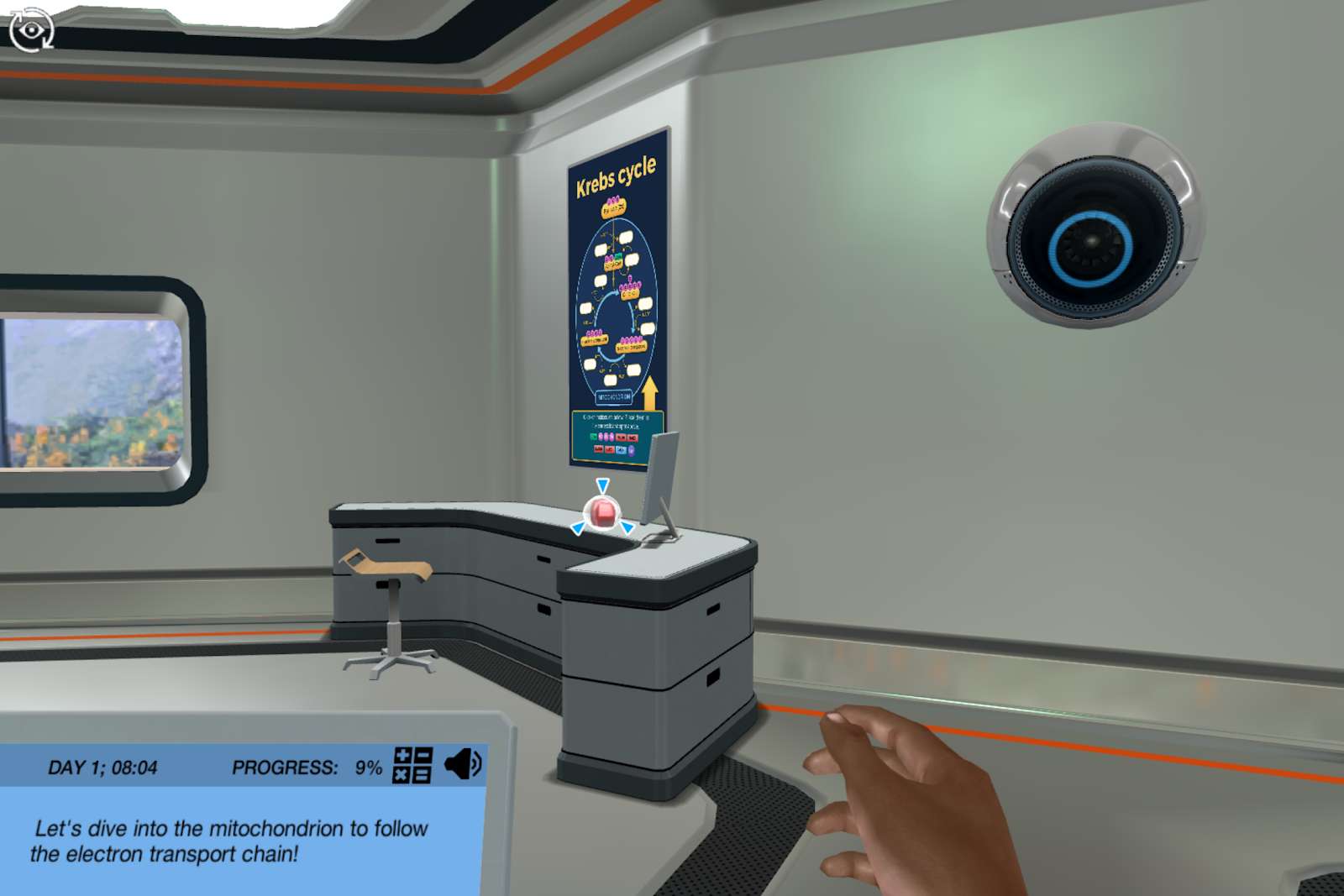Heading 1
Heading 2
Heading 3
Heading 4
Heading 5
Heading 6
Lorem ipsum dolor sit amet, consectetur adipiscing elit, sed do eiusmod tempor incididunt ut labore et dolore magna aliqua. Ut enim ad minim veniam, quis nostrud exercitation ullamco laboris nisi ut aliquip ex ea commodo consequat. Duis aute irure dolor in reprehenderit in voluptate velit esse cillum dolore eu fugiat nulla pariatur.
Block quote
Ordered list
- Item 1
- Item 2
- Item 3
Unordered list
- Item A
- Item B
- Item C
Bold text
Emphasis
Superscript
Subscript
About This Simulation
Take dive inside a mitochondrion to learn all about the electron transport chain (ETC) and pass on your findings to the basketball team so they can learn too!
Learning Objectives
- Detail the movement of electrons through the mitochondrial electron transport chain
- State the end products of aerobic respiration
- Describe where the electron transport chain and its component complexes are located in cells
About This Simulation
Lab Techniques
Related Standards
- HS-LS1-7
- Biology 3.6 Cellular Respiration
- Biology 8.2 Cell respiration
Learn More About This Simulation
This short, targeted simulation is adapted from the full-length “Cellular Respiration” simulation.
What is the electron transport chain and how is it linked to the Krebs cycle? In this simulation, you will cover the final stage in aerobic respiration, the electron transport chain. After the Krebs cycle, you won't have to travel far, as you will be shrunken down and squashed inside a mitochondrion. Here, we will make an abstract concept become a mechanism which can be visualised through a colourful and engaging animation.
Evaluate the Electron Transport Chain
Firstly, you will be transported straight from the high-tech laboratory to right inside a mitochondrion using our cutting-edge shrink rays and teleportation machine! Here, you will learn about the stages that take place in the electron transport chain by getting up close and personal with the transmembrane proteins. You will see how the products of the Krebs cycle get the motor running and the reactions which take place at each stage, along with verbal explanations. You will have the ability to visualise the mechanics of the ETC - something even real-life laboratories cannot do!
Review your Knowledge
After a thorough explanation of the ETC you will be prompted with some engaging quiz questions to reinforce your knowledge to further your learning of cellular respiration. To accompany the quiz questions there are relevant theory pages and informative diagrams to aid your learning.
Help athletes perform
After exploring the final stage of aerobic respiration you will be ready to pass on your knowledge to the basketball players, so they can improve their diet and training regime to remain energized.
For Science Programs Providing a Learning Advantage
Boost STEM Pass Rates
Boost Learning with Fun
75% of students show high engagement and improved grades with Labster
Discover Simulations That Match Your Syllabus
Easily bolster your learning objectives with relevant, interactive content
Place Students in the Shoes of Real Scientists
Practice a lab procedure or visualize theory through narrative-driven scenarios


FAQs
Find answers to frequently asked questions.
Heading 1
Heading 2
Heading 3
Heading 4
Heading 5
Heading 6
Lorem ipsum dolor sit amet, consectetur adipiscing elit, sed do eiusmod tempor incididunt ut labore et dolore magna aliqua. Ut enim ad minim veniam, quis nostrud exercitation ullamco laboris nisi ut aliquip ex ea commodo consequat. Duis aute irure dolor in reprehenderit in voluptate velit esse cillum dolore eu fugiat nulla pariatur.
Block quote
Ordered list
- Item 1
- Item 2
- Item 3
Unordered list
- Item A
- Item B
- Item C
Bold text
Emphasis
Superscript
Subscript
A Labster virtual lab is an interactive, multimedia assignment that students access right from their computers. Many Labster virtual labs prepare students for success in college by introducing foundational knowledge using multimedia visualizations that make it easier to understand complex concepts. Other Labster virtual labs prepare learners for careers in STEM labs by giving them realistic practice on lab techniques and procedures.
Labster’s virtual lab simulations are created by scientists and designed to maximize engagement and interactivity. Unlike watching a video or reading a textbook, Labster virtual labs are interactive. To make progress, students must think critically and solve a real-world problem. We believe that learning by doing makes STEM stick.
Yes, Labster is compatible with all major LMS (Learning Management Systems) including Blackboard, Canvas, D2L, Moodle, and many others. Students can access Labster like any other assignment. If your institution does not choose an LMS integration, students will log into Labster’s Course Manager once they have an account created. Your institution will decide which is the best access method.
Labster is available for purchase by instructors, faculty, and administrators at education institutions. Purchasing our starter package, Labster Explorer, can be done using a credit card if you are located in the USA, Canada, or Mexico. If you are outside of North America or are choosing a higher plan, please speak with a Labster sales representative. Compare plans.
Labster supports a wide range of STEM courses at the high school, college, and university level across fields in biology, chemistry, physics, and health sciences. You can identify topics for your courses by searching our Content Catalog.















